A Glass of Sugar Cane Syrup and Lime
Article and photos by Stephanie Rachel Dyson
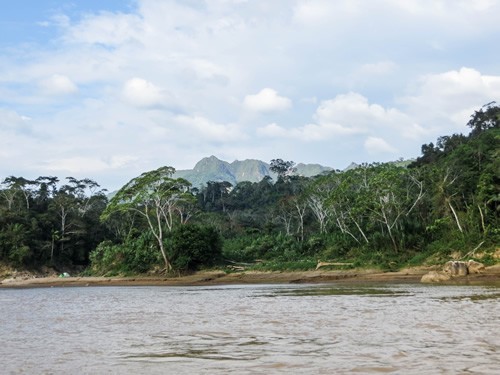
|
|
A view of the shore of the river Bení in Bolivia.
|
Life is unhurried here.
The steady push of the brown water against the shore is the fastest movement. Inside the jungle, people work slowly; there is always time to talk, to pause in the shade of a towering banana plant. To pass the time of day.
Plentiful moments exist when sharing a cold beer with your neighbor. You savor the icy, refreshing liquid on a bench outside your house. It is the product of some unexpected jungle magic or hidden cool box.
The gentle cacophony of the rainforest, the sultry heat of the rapidly evaporating moisture, and the slow, calm flow of the River Bení nearby, This is jungle life.
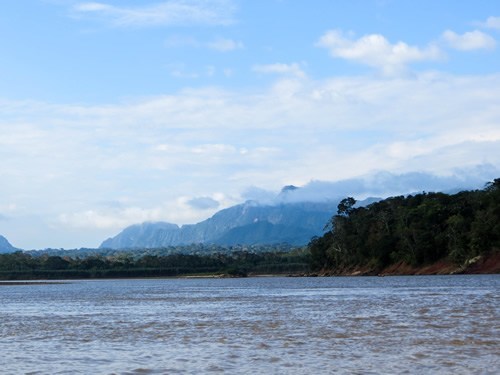
|
|
Sense the calm flow of the river Bení.
|
Unhurried, steady, composed.
Our boat chugs gently upstream, its motorized engine contrasting with the traditional boats we pass: those hollowed out of single, enormous tree trunks. They are a sign that life outside Mother Nature's stronghold – the Amazon – is changing. Our captain salutes each passing vessel, acknowledging acquaintances from the distant communities once buried deep in the jungle.
Plastic bottles—thrown casually overboard by a local's hand, a tourist's, who knows—float passively in the brown eddies that spiral past us, heading back to where they came from. Downriver, Rurrenabaque has reared up out of the land: a place of dusty motorcycles, white plastic tables lounging on pavements, and wealthy, expectant tourists.
We visit the Bolivian Amazon during the dry season; these are the kinder months of the year. Relics of past summers bear testament to the changeable temperament of nature. Beaches, stolen from further upstream and carried by the swollen tides of water, now appear as new islands. They bear the carcasses of the trees which deluges of mahogany liquid ripped whole from the banks.
Last season, feral currents swallowed ancient boughs, innocent saplings, and entire houses into their wild depths, idly spitting their remains back out when the waters finally retreated.
These are forces that local people cannot control.
But despite this, life remains unhurried, relaxed, and welcoming. The river, now deceptively calm, continues its steady movement.
Stepping off the boat, the heat ignites. As we leave behind the wind tunnel of the river, the humidity penetrates our clothing within seconds, matting our hair tightly against our necks and leaving trails of moisture to trickle down our backs.
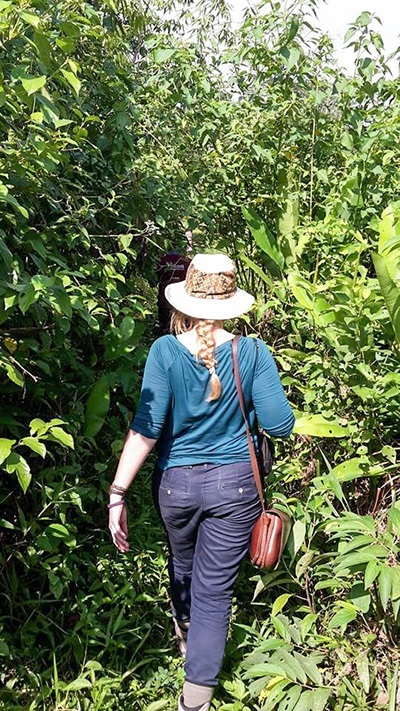
|
|
Entering the sugar cane plantation after stepping off a boat.
|
Sodden, within a few short steps, we are welcomed into the home of Señora Mamio. She is a woman in her late fifties — although age is constructed differently closer to the equator, where the cruel legacy of the sun, the deep lines and cracks in faces, claim years that the bearer has not yet seen.
My fingers ache to photograph our host, her home, and her life. The flash of a camera seems intrusive here. I resist.
Señora Mamio's home is a one-roomed shack stolen from the surroundings: thick timber planks form the shell, and woven palm leaves make up the roof. The house is propelled from the jungle floor by a base of wooden stilts, anticipating the inevitable rise of the river. A barbed fence separates it from her two fields: one for sugar cane and the other for livestock — a handful of cows grazing on a small patch of cleared ground.
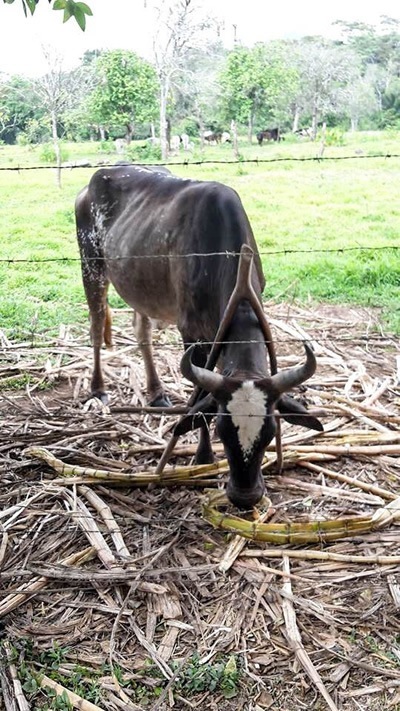
|
|
Cow grazing in the jungle.
|
Surprisingly, Señora Mamio's land seems untouched by the whims of the rainy season. It is hard to imagine the flooding, the murky wash of water that now has taken to reclaiming the land each summer, making a point of re-establishing its authority — just in case the communities might have forgotten. The river flows a mere few meters from her sugar cane plantation, but the thickness of the vegetation almost manages to obscure it from view.
The house is sturdier than others we'd seen on our journey into the jungle. Further downstream, we pushed our wooden boat up onto the bank and clambered out to visit a village that had once bordered the river. Now, for safety's sake, it can be found two hundred meters into the mix of heavy trunks, papaya plants, and sprawling creepers: an attempt to escape the reach of the malicious waters.
Luis, our guide, had shown us the remains of the town hall – a grandiose term for a building that had been a single room with a palm roof. It was lost to the raging currents a few summers ago, as the river swelled beyond memory and reclaimed the land on which the community had built their village.
Further inland was the village school, another one-roomed building bearing the legacy of flooding. We saw the waterline of yellowed, flaking paint reaching almost the entire way up the walls of the tiny classroom and cautioning against any underestimation of next year’s inundation.
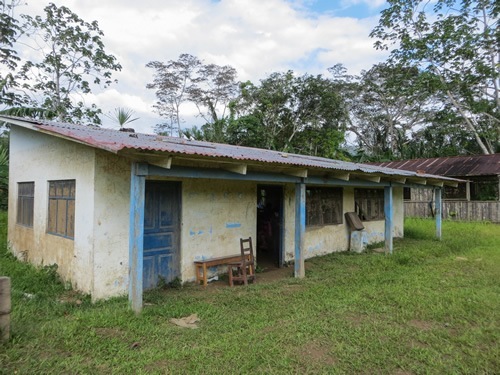
|
|
The village school.
|
But here on Señora Mamio’s plantation, she seems to control this age-old enemy. Here, life is unblemished and calm; raging Amazonian waters pass unnoticed on the edges of her land.
In front of her house, a large table – again seized from the jungle – resides beneath the shade of a tree, and four men line its edges, listening to distant, indigenous music escaping from a battery-powered radio. Their clothes are dusty in patches, mended in others; sweat bleeds from their armpits and collars. Caps, all of which bear slogans of Northern American football teams, provide respite from the sky’s piercing brightness.
Our captain saunters to join them, lowering himself to straddle the bench. This is his customary seat where he waits for the tourists to do their business.
They nod in greeting, a short "hola, buenos días" — anything more is unnecessary in this heat. Gazes linger on us — we have become accustomed to this attention — and are broken only when Luis beckons us to follow.
We pass into what can only be described as the yard; an expanse of baked earth, dried to dust by the unrelenting sun and the lack of vegetation which once would have kept the ground moist. A small group of black, velveteen-skinned pigs shuffle through the dust, grunting in their pursuit of bugs or food remnants before collapsing into a heap of soft limbs to rest in the dirt.
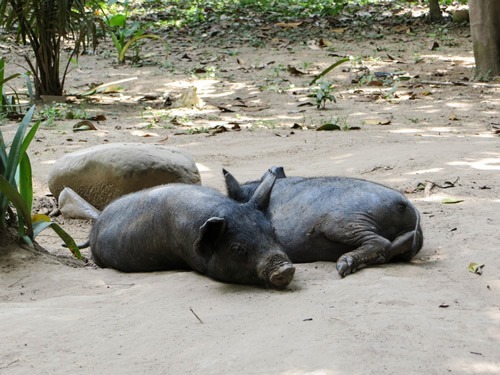
|
|
Bolivian pigs sleeping.
|
Weaving between the house's stilts are a brigade of chicks; like the pigs, they prey on the sandy ground beneath, chirping through optimistic pecking. One resembles a penguin strikingly: its feathers are black with a stripe of white down its front.
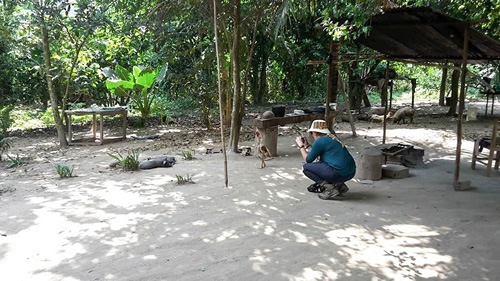
|
|
Farmyard.
|
“Pinguino!” Harriet, my companion, shouts before collapsing into laughter at how strange the moment must seem to our Bolivian hosts, who must think we’ve never seen a chicken before.
Our laughter forks through the afternoon lull; it flattens the grasshoppers' percussion and the parrots' calls cresting the treetops.
We are loud and alien in this environment. We fall silent again.
Señora Mamio is sure-footed as she threads between the sugar cane. Every few meters, she stops to inspect the towering plants, plucking a dead leaf here or a full cane there — gathering the required resources for the tourist spectacle that will follow. We are more cautious, tentatively stepping on the debris underfoot, conscious of what could be hidden in the undergrowth. Our suspicions are later confirmed when Luis enthusiastically shows us tarantulas lurking in the center of a pineapple plant.
The gathered sugar canes are stripped of their brown leaves to leave the hard cane stalk. We are directed to what, upon first inspection, appears to be an instrument of torture but turns out to be her mill for extracting the sticky syrup.
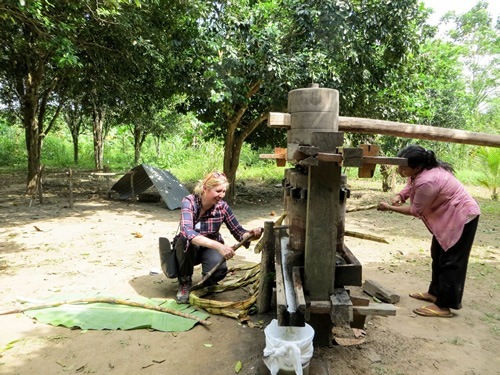
|
|
Mamio and Harriet feed the sugar cane into the press.
|
It consists of three rounded barrels, each separated by a fraction of a space and rotated by a wooden plank attached to the top. The sugar cane is fed from a perfectly fork-shaped branch beside the machine into the gap between the barrels. It is pulled and squeezed there until the thick liquid is released into a narrow trench beneath the mill. The canes are twisted and flattened; finally, they are removed and thrown back into the jungle.
This is what the tourists come for.
As Harriet and Señora Mamio start feeding the wooden machine and I take the wooden lever, I wonder how much of her sugar cane is sold in the town downstream and how much is purely for entertaining tourists. I pass round and round, moving in a wide circle with Harriet limboing beneath me. As the tree branch picks up speed, I become like one of the currents on the river, and the air almost swallows me into its dizzying abysss.
Suddenly, the branch's weight lightens, and I realize that one of the men from the table has lumbered over to join me. His muscles tense against the friction the trapped sugar cane produces, and I know how redundant I've become. I am out of my depth, weak, and unprepared for manual labor in an environment where hard, physically demanding work is the essential requirement of life. He propels the branch forward, almost leisurely, as I battle with the humidity and my legs to keep to his pace.
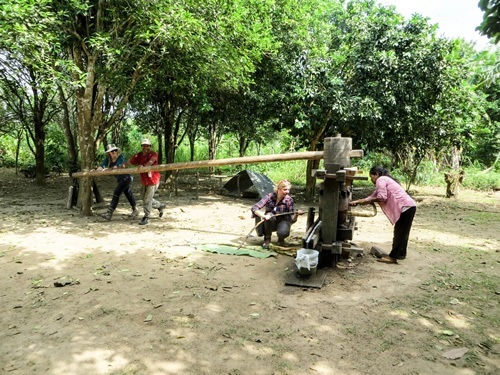
|
|
Author and Luis turn the press as Harriet and Mamio feed the sugar cane.
|
The other men watch us from the table; no comments are passed. Instead, customary silence reigns as they observe the spectacle. Wafts of Bolivian music reach us from their radio, giving our efforts a leisurely tempo.
Almost unexpectedly, the juice trickles and then streams through the channel and onto the floor. A bucket is fetched, and the milky, yellow liquid spills into the receptacle as we continue turning, limboing, and pushing in a centuries-rehearsed rhythm of syrup production.
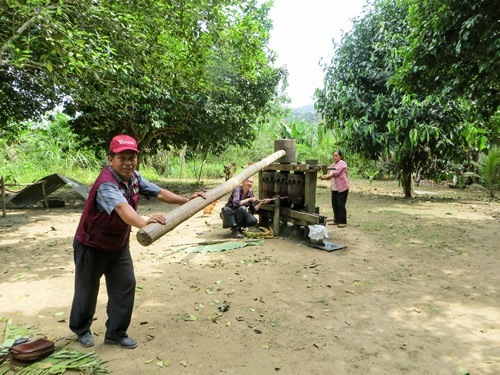
|
|
Luis continues the hard work of turning the press as Harriet and Mamio feed the sugar cane.
|
We continue until the eight canes have been thoroughly mangled and squashed, and the fruits of our labor are half a bucket of pure syrup. It is carried proudly to the table, born by hands sticky and dripping with sweat from the exertion.
Señora Mamio gestures for us to join the others at the table, introducing us to her husband, son, and assembled neighbors. Ice is fetched from a cool box near the bushes, and chaos ensues as one attempts to break the ice into chunks. A puddle of ice-cold water seeps across the table and drips refreshingly onto our legs.
Lumps are added to the syrup and stirred; colored plastic cups and lime quarters are fetched.
We are invited to serve ourselves.
The thick liquid pours into our glasses, and the chunks of ice splash sticky, sweet drops onto our hands. We squeeze lime into the mixture and drink. It is refreshing, but the purity of the sugar lingers across my teeth, and even the sharpness of the lime does little to cut through the thick sweetness.
Our hosts are slurping back shots of the mixture, pouring multiple glasses. Their capacity to drink so much sugar in one sitting is impressive.
The ice has quite literally been broken, and the drink seems to inspire conversation. Our hosts are keen to know where we are from, what we think of Bolivia, what we think of their home.
“How are you?”
“What is your name?”
Señor Mamio offers a sudden burst of distantly recalled English, and we reciprocate: despite ten months in the country, my Spanish remains hesitant, laborious, and muffled by a foreign tongue trespassing on new territory. Despite our faltering starts, we gain confidence and regale them with ludicrous tales of confusion in this new language: Harriet introduces herself as the number eight, and I accidentally call myself "Parrot."
There is a feeling of understanding; they know what it means to be alien to Spanish — or Castellano — as a tongue. Most people in this part of the jungle were raised to speak Tacna, one of the countless indigenous languages. They recognize our battles.
Our collective laughter sweats into the air as a cloud of unexpected cultural exchange. Gazes soften, and the atmosphere feels warmer, more open, and less guarded.
But, despite our revelry, our actual names are not shared, and the moment for offering this simple information soon evaporates into the heat.
The final drops of the syrup linger at the bottom of the bucket. We have drunk on the tranquility of the jungle, laughed manically, and swapped our lives between mouthfuls of sugar cane.
I wonder how many of us there have been before and how many there will be after? Who else has made them laugh and enjoy the company of people so strange, so unlike them, so ignorant of their way of life here?
Have we offered light relief from the stunted English conversations, a brief moment of unexpected communication in the searing heat of an Amazonian afternoon?
But what do they really think of us beneath the smiles and the hospitable laughter?
Luis gestures that we must leave. The goodbyes are warmer than the welcome: hands shake, cheeks accept brief kisses, wishes of buena suerte are made, thank yous are uttered.
Retracing our route to the boat, we leave them as we found them: sat quietly around the table, the release of words now subdued and replaced with a calm, unhurried contemplation.
Maybe they are waiting for the next tourists for the repeat of this daily moment of cultural collision over an icy glass of sugar cane syrup and lime.
Maybe they are just waiting for the day to pass, for the hours to trickle back into nighttime.
Maybe they are waiting for the inevitable march of time: the onslaught of change that the motor boats and the electric lights of Rurrenabaque prophesize. Have they learned to control, or even understand this new foe?
Maybe that’s who they’re waiting for.
We climb back into our boat. The river is as placid and calm as our hosts, and as the vessel pushes back into the waters, and the engine awakens with a thick grunt, the river laps against the sides, lazily.
Life is unhurried here.
Steph Dyson is a travel writer and volunteer who advocates slow, adventurous travel. Since 2014, she has lived, volunteered, and simply breathed everything that is South America. Find her at WorldlyAdventurer.com.
|
